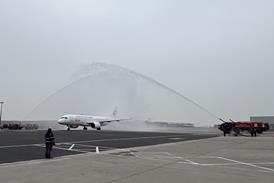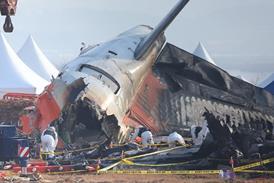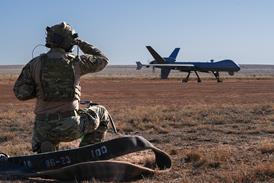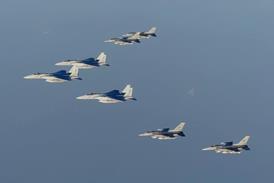The widebody market is as tight as it has ever been, stretched by record orders and delays to the Airbus A380 and Boeing 787 programmes, leaving carriers fighting over a scarce resource
When it comes to the ability of airlines to source long-haul aircraft for near-term delivery these days, the words needle and haystack spring to mind. Record orders at both Airbus and Boeing in 2007, driven by strong and ever-growing demand from carriers in emerging markets such as China and India, combined with delays to the A380 and 787 programmes, which have left airlines scrambling for widebodies to temporarily bridge the gap, have resulted in an extremely tight market where demand far outstrips supply.
The noose around the market's neck is showing little sign of loosening for the moment. However, some believe the economic downturn will cause carriers to re-evaluate their plans for capacity growth and that order cancellations will be inevitable.
 |
|---|
"We're hoping we can pick something up that is currently locked into a slot with another airline" Tim Bye Deputy chief executive, bmi |
Bmi is looking to add five A330s to its fleet but due to the scarcity of available aircraft of this type, the carrier has been forced as an interim measure to damp-lease two Boeing 757-200s from fellow UK operator Astraeus. "We did this because we were struggling to find A330s," says Bye. "The agreement is for two years with an option to extend, which gives us flexibility if we don't get the A330s." He adds that used long-haul aircraft are also "very difficult to get hold of at the moment", which has led to queues of airlines banging on the doors of the leasing companies and driving up prices: "The second-hand aircraft that are available have had multiple bidders for them and lessors are willing to sign three or four letters of intent for one aircraft and then secure the best deal."
On the prowl
Another airline that is ready to pounce in the event that aircraft currently accounted for in the order books hit the market again is Qantas low-cost unit Jetstar, which is on the hunt for stop-gap widebodies to cover for the expected year-long delay to the delivery of its 787s. Jetstar general manager network Pete Yap says that as the carrier awaits its 787s it plans to lease A330-200s, although other options would be considered if the A330 proves too elusive. "Ideally we would like to get A330-200s because they are known to us, but we're looking at everything short of a [Boeing] 747," says Yap. "We want something in the 250-300-seat range, so we're looking at A330s, 777s, anything - we're just seeing what's out there. Because we can't get delivery slots until a few years out we're looking to see if any airlines cancel or defer orders to see if we could take some deliveries sooner. If another Airbus or Boeing customer or lessee changes their plans, we'd be interested."
Hawaiian Airlines is also on the lookout for bridge aircraft as it awaits deliveries of the six A330-200s and six A350s it has on firm order from Airbus. Hawaiian chief financial officer Peter Ingram says the earliest delivery dates it could get from Airbus for these aircraft were 2012 for the A330s and 2017 for the A350s. In the meantime, the Honolulu-based carrier is hoping to lease some A330s as its number one choice, but would also consider extending the leases on some of its existing 767s as a second option. "In the interim, having made the decision to transition from a 767 fleet to an A330 and A350 fleet, we are working now to provide replacements for the airplanes coming off lease," says Ingram.
"Ideally, we would like to start the A330 transition sooner rather than later, preferably by 2010. But we're finding that the market is fairly tight - there are a small number of new aircraft from lessors available and we're in discussions with them." Ingram acknowledges that "delays with the 787 and strong international demand mean those aircraft are in high demand and operators are choosing to keep the aircraft they have, so the lessors are in a pretty good position".
However, he believes Hawaiian will find what it is looking for without too many problems. "We're a relatively small airline with 18 widebodies, so I think we'll be able to find the aircraft we need and work collaboratively with lessors on solutions for the interim period," he says. "We will have to evaluate on a case-by-case basis whether to sign up [for aircraft] or wait for the market to cool off."
One carrier that is directly impacted by the 787 delays, Jetstar, was originally scheduled to take delivery of the first of 15 787s in August of this year, but Yap estimates that the programme delays will likely push this back by approximately one year. "At this point we don't have a confirmed delivery stream from Boeing, but we're planning for mid-2009. We hope to find out by mid-April," he says.
"If another Airbus or Boeing customer or lessee changes their plans we'd be interested" Pete yap General manager network, Jetstar |
Tinseth also disagrees with the notion put forward by bmi, Jetstar and others that aircraft currently on order will start to become available again as airlines revise their growth plans in light of a potential downturn. "We don't speculate on orders, but many airplanes on order are targeted for replacement of less fuel efficient aircraft. The airlines that have ordered have been rather thoughtful and measured in their approach to the market," he says. "When we look at our backlog we have a very nice balance by region and by airline business model, and we are very encouraged by that. We have a high degree of confidence that those aircraft will more than likely deliver to the airlines that ordered them."
Desert outcasts
There are other aircraft ready and waiting for new owners, says Tinseth, but because they are older and less economical on fuel burn they are being shunned in favour of newer models, despite the waiting lists: "There are a number of less fuel efficient planes sitting in the desert so there are older aircraft available, but with fuel at record prices airlines are looking for more fuel efficient aircraft."
Airbus chief operating officer customers John Leahy agrees, noting that "airlines are retiring aircraft earlier than they otherwise would have under low price oil".
Both Airbus and Boeing experienced record orders in 2007, with the former racking up net orders for 1,341 jets against the latter's 1,413. Leahy points to strong demand from emerging markets driving the "three years of way above the trend line" in orders. He predicts "China and India will be in the top five GDP by 2026" and "Asia will be the number one market in the world" by the same year.
However, there are signs that this year could see a cooler environment for orders at both Airbus and Boeing, with Leahy predicting that sales in 2008 will be half the level recorded in 2007. Boeing is less forthcoming in putting a figure on this year's projected orders, but nevertheless Tinseth says: "We've had an incredible run over the last three years and I would characterise orders this year as strong but at more normal levels. We expect to deliver 475 to 480 aircraft this year and while we don't do a good job of projecting orders we do expect to add to our backlog." Boeing delivered 441 aircraft in 2007.
While carriers in emerging markets have been ordering aircraft in record numbers, the same cannot be said for the US airlines. Leahy does not expect US carriers to start placing orders in any great number until they decide what to do about mergers and acquisitions. "The first thing that's got to happen in the US market is consolidation," he says. "They have to link up and look at each other's fleet plans over the next two years and say, 'what do we have that's common?' The number one consideration at the moment is consolidation, not fleet renewal."
Decision time
Tinseth agrees with his rival that "a number of US airlines have consolidation on their minds", and says carriers "will look very hard at their fleet mix as they get close to consolidation". However, he warns, particularly on the single-aisle aircraft front, that "if [US carriers] don't take action soon, by 2015 they will have 800 to 900 aircraft that are 25 years old, or older. If they want to continue to be viable competitors they need to make a decision in the next year or two."
 |
|---|
"We're finding the market istight - there are a small number of new aircraft from lessors available" Peter Ingram Chief financial officer, Hawaiian Airlines |
One US carrier that has been placing orders to renew its long-haul fleet is Continental Airlines, which has ordered eight 787-8s and 17 787-9s from Boeing. However, the carrier is warning that its capacity growth plans could be impacted by the delays to the 787. Continental was originally scheduled to take delivery of its first three 787s in 2009, but this could now change given that Boeing has pushed back the date for its initial 787 deliveries from May 2008 to early 2009. In its annual report for 2007, Continental says: "Boeing has not informed us of the effect, if any, this latest delay will have on our scheduled deliveries. However, it is possible that our deliveries could be significantly delayed.
"Our mainline capacity growth for 2009 and thereafter may be reduced below our target range if there are significant delays in the scheduled deliveries of our Boeing 787 aircraft, particularly if we are unable to make alternative arrangements to acquire long-range aircraft on commercially acceptable terms." Continental is hoping to grow its long-term capacity by between 5% and 7% annually.
Other carriers affected by the scarcity of available widebodies are also finding their growth plans impacted and are having to make network adjustments while they wait for aircraft. Jetstar, for instance, has been turning its focus towards expanding its short- and medium-haul international network as it continues to hunt for bridge aircraft. "We placed a narrowbody order for 68 A320s in November and we're looking to expand into other short-haul international flying," says Yap. "We can get into ports in southeast Asia using Perth and Darwin as two potential gateways, so there are ways of getting into international markets without widebodies."
Long-haul delay
South Africa's Comair has also postponed plans to enter the long-haul market, partly blaming this decision on a lack of available aircraft. Comair late last year secured rights to serve London. It said at the time that it was looking to acquire a Boeing 767 with which to launch the service in 2008. But Comair joint chief executive Gidon Novick now says long-haul services are "not a priority at this stage", citing the tight market for long-haul aircraft as one of the reasons for delaying a decision.
"It's not a buyers' market and we're not desperate to get on to the [London] route, so it's better to wait," says Novick, adding that Comair will take a decision "in the next few months" on whether to eventually enter the long-haul market. If the carrier does opt to branch into this market, it would be looking for 767-200/300ERs. "We've got our feelers out but we are aware that there is a shortage of long-haul aircraft," says Novick.
For how long will the market remain this tight, and when will the situation start to change? That, it seems, is the million dollar question which has the industry scratching its head. Boeing's Tinseth says he "can't foresee a tipping point", adding: "I see this situation existing into the foreseeable future. I expect to see robust deliveries into the next decade."
Bye at bmi believes it's a case of wait and see. "Over the last few months there has been the view that we're at the top of the cycle and the aircraft market would get less tight. But that remains to be seen," he says.
To see how the lessors are benefiting from booming orders, visit flightglobal.com/leasing
Source: Airline Business























